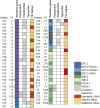The in vitro Activity of Omadacycline Alone and in Combination Against Carbapenem-Resistant Klebsiella pneumoniae
- PMID: 39734741
- PMCID: PMC11675304
- DOI: 10.2147/IDR.S473546
The in vitro Activity of Omadacycline Alone and in Combination Against Carbapenem-Resistant Klebsiella pneumoniae
Abstract
Objective: This study aimed to evaluate the in vitro activity of omadacycline (OMC) and OMC-based combination therapy against carbapenem-resistant Klebsiella pneumoniae (CRKP).
Methods: The broth microdilution assay assessed the in vitro susceptibility of CRKP to OMC. The checkerboard assay was performed to evaluate the activity of OMC combined with polymyxin B (PB), amikacin (AN), or meropenem (MEM) against KPC-producing (class A) CRKP strains, and OMC combined with PB, aztreonam (ATM), MEM, or AN against class B and class A plus class B CRKP strains. Synergistic effects of OMC and PB were further evaluated by time-kill assays in the KPC-producing CRKP strains.
Results: Broth microdilution assays revealed a notable variation in susceptibility between KPC-producing and class B CRKP strains, with MIC50/90 of 32/32 mg/L and 0.5/8 mg/L, respectively. Although KPC-producing CRKP strains were resistant to OMC, a synergistic effect was observed in 37.5% of KPC-producing CRKP strains when OMC was combined with PB. In the nine KPC-producing CRKP strains, time-kill assays found that cell densities of six strains (66.7%) decreased by 3.61 ± 0.23 log10 CFU/mL compared to the initial inoculum after 2 hours of PB exposure. The cell densities further decreased by an average of 2.38 ± 0.23 log10 CFU/mL when the six strains were exposed to OMC plus PB, confirming their potent synergism.
Conclusion: OMC monotherapy is ineffective against KPC-producing CRKP strains, but OMC plus PB has a potent synergistic effect on them, suggesting that OMC plus PB is the preferred combination therapy against KPC-producing CRKP in vitro.
Keywords: Klebsiella pneumoniae; antibiotic combination treatment; carbapenem resistance; omadacycline; polymyxin B; time-kill test.
© 2024 Du et al.
Conflict of interest statement
The authors report no conflicts of interest in this work.
Figures



Similar articles
-
Effect of ceftazidime-avibactam combined with different antimicrobials against carbapenem-resistant Klebsiella pneumoniae.Microbiol Spectr. 2024 Jun 4;12(6):e0010724. doi: 10.1128/spectrum.00107-24. Epub 2024 May 7. Microbiol Spectr. 2024. PMID: 38712934 Free PMC article.
-
Effectiveness of antimicrobial agent combinations against carbapenem-producing Klebsiella pneumoniae with KPC variants in China.Front Microbiol. 2025 Jan 22;15:1519319. doi: 10.3389/fmicb.2024.1519319. eCollection 2024. Front Microbiol. 2025. PMID: 39911707 Free PMC article.
-
In vitro and in vivo bactericidal activity of ceftazidime-avibactam against Carbapenemase-producing Klebsiella pneumoniae.Antimicrob Resist Infect Control. 2018 Nov 21;7:142. doi: 10.1186/s13756-018-0435-9. eCollection 2018. Antimicrob Resist Infect Control. 2018. PMID: 30479755 Free PMC article.
-
[Evaluation of In Vitro Efficacy of Ceftazidime-Avibactam, Meropenem, and Colistin Single and Binary Combinations Against Carbapenem Resistant Klebsiella pneumoniae Strains Isolated from Various Clinical Specimens].Mikrobiyol Bul. 2022 Apr;56(2):230-250. doi: 10.5578/mb.20229804. Mikrobiyol Bul. 2022. PMID: 35477227 Turkish.
-
In vitro and in vivo Effect of Antimicrobial Agent Combinations Against Carbapenem-Resistant Klebsiella pneumoniae with Different Resistance Mechanisms in China.Infect Drug Resist. 2021 Mar 5;14:917-928. doi: 10.2147/IDR.S292431. eCollection 2021. Infect Drug Resist. 2021. PMID: 33707959 Free PMC article.
Cited by
-
Clinical Efficacy and Safety of Omadacycline Versus Tigecycline in Treating Severe Pneumonia Caused by Carbapenem-Resistant Gram-Negative Bacilli: A Retrospective Cohort Study.Infect Drug Resist. 2025 Sep 4;18:4699-4710. doi: 10.2147/IDR.S541192. eCollection 2025. Infect Drug Resist. 2025. PMID: 40926873 Free PMC article.
-
Antibacterial activity of eravacycline against Klebsiella pneumoniae isolates: an in vitro study.Microbiol Spectr. 2025 Jul;13(7):e0256424. doi: 10.1128/spectrum.02564-24. Epub 2025 May 30. Microbiol Spectr. 2025. PMID: 40445203 Free PMC article.
References
-
- Zhen X, Stålsby Lundborg C, Sun X, Gu S, Dong H. Clinical and economic burden of carbapenem-resistant infection or colonization caused by Klebsiella pneumoniae, Pseudomonas aeruginosa, Acinetobacter baumannii: a multicenter study in China. Antibiotics. 2020;9(8):514. doi:10.3390/antibiotics9080514 - DOI - PMC - PubMed
-
- Wang M, Earley M, Chen L, et al. Clinical outcomes and bacterial characteristics of carbapenem-resistant Klebsiella pneumoniae complex among patients from different global regions (CRACKLE-2): a prospective, multicentre, cohort study. Lancet Infect Dis. 2022;22(3):401–412. doi:10.1016/s1473-3099(21)00399-6 - DOI - PMC - PubMed
-
- Tamma PD, Aitken SL, Bonomo RA, Mathers AJ, van Duin D, Clancy CJ. Infectious Diseases Society of America 2022 Guidance on the treatment of extended-spectrum β-lactamase producing enterobacterales (ESBL-E), carbapenem-resistant enterobacterales (CRE), and Pseudomonas aeruginosa with difficult-to-treat resistance (DTR-P. aeruginosa). Clin Infect Dis. 2022;75(2):187–212. doi:10.1093/cid/ciac268 - DOI - PMC - PubMed
LinkOut - more resources
Full Text Sources
Research Materials
Miscellaneous

